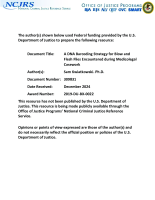Corpses
Bacterial Symbionts and Taphonomic Agents of Humans
Improved DNA Recovery and STR Profile Development from Weathered Bos Taurus Bones using Demineralized Bone Slices
Unmanned Aerial Systems for the Search and Documentation of Clandestine Remains
Insect Development as it Relates to Forensic Entomology
Using Microbiome Tools for Estimating the Postmortem Interval
Modeling Human Decomposition: A Bayesian Approach
Validation of the Total Body Score/Accumulated Degree-Day Model at Three Human Decomposition Facilities
A Comparison of Human and Domestic Pig Decomposition Using Multivariate Methods
Developmental Variation Among Cochliomyia Macellaria Fabricius (Diptera: Calliphoridae) Populations from Three Ecoregions of Texas, USA
Testing the Use of Pigs as Human Proxies in Decomposition Studies
An Examination of Commingled First Tarsometatarsal and Atlantoaxial Joints by Deviation Analysis
Verification of Eye and Skin Color Predictors in Various Populations
Interpretable Deep Learning-Based Forensic Iris Segmentation and Recognition
Assessing the Utility of Soil DNA Extraction Kits for Increasing DNA Yields and Eliminating PCR Inhibitors from Buried Skeletal Remains
Association of Commingled Human Skeletal Remains by Their Elemental Profile Using Handheld Laser-induced Breakdown Spectroscopy
Pre-grouping of Commingled Human Skeletal Remains by Elemental Analysis
The Collection, Preservation, and Processing of DNA Samples from Decomposing Human Remains for More Direct Disaster Victim Identification (DVI)
Physical and Biochemical Factors Affecting the Recovery and Analysis of DNA from Human Skeletal Remains
A Virtual Anthropological Approach to the Study of Commingled Human Remains
Overview of Forensic Anthropology
Forensic anthropologists examine skeletal human remains to assess age at death, sex, stature, and ancestry; identify injuries; and estimate the time since death to provide investigators with information that can assist in identifying a decedent.
Forensic odontologists examine the development, anatomy, and any restorative dental corrections of the teeth, such as fillings or extractions, to make a comparative identification of a person.
Bones and teeth are...
Overview of Forensic Pathology
Human remains are treated as a separate and unique type of forensic evidence. An autopsy of the remains is conducted to establish the cause and manner of any death that is violent, unusual or untimely. A forensic pathologist completes a post-mortem examination and examine death scene findings. The medical history of an individual may also be reviewed to help determine if the death was natural...




